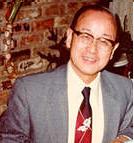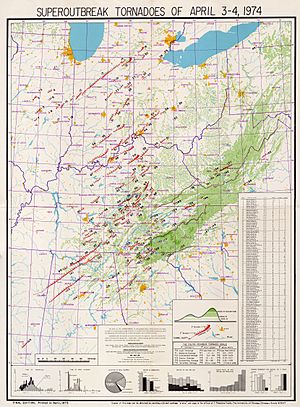Ted Fujita facts for kids
Quick facts for kids
Ted Fujita
|
|
|---|---|
 |
|
| Born | October 23, 1920 Sonemura, Kiku-gun, Fukuoka Prefecture, Empire of Japan
|
| Died | November 19, 1998 (aged 78) |
| Citizenship | Japan and United States (1968) |
| Alma mater | Kyushu Institute of Technology (B.S., 1943) University of Tokyo (D.Sc., 1950) |
| Known for | tornadoes, tornadic storm morphology, Fujita scale, multiple-vortex tornadoes, downbursts, microbursts, mesoscale meteorology |
| Children | Kazuya Fujita |
| Awards | Order of the Sacred Treasure, Gold and Silver Star (1991) |
| Scientific career | |
| Fields | Meteorology |
| Institutions | University of Chicago |
| Thesis | Analytical Study of Typhoons (1952) |
| Doctoral advisor | Shigekata Syono |
| Doctoral students | Roger M. Wakimoto, Gregory S. Forbes |
Tetsuya Theodore Fujita (/fuːˈdʒiːtɑː/; foo-JEE-tah) (藤田 哲也, Fujita Tetsuya, October 23, 1920 – November 19, 1998) was a Japanese-American meteorologist. He was a scientist who studied the weather. His main work focused on severe weather, like strong thunderstorms and tornadoes.
Fujita's research at the University of Chicago changed what we knew about these powerful storms. He studied thunderstorms, tornadoes, hurricanes, and typhoons. He is best known for creating the Fujita scale. This scale helps measure how strong tornadoes are and how much damage they cause. He also discovered downbursts and microbursts. These are strong, sudden winds that can be very dangerous.
Contents
About Ted Fujita
Ted Fujita was born in a village called Sone in Fukuoka Prefecture, Japan. This area is now part of the city of Kitakyushu. He studied and taught at the Kyushu Institute of Technology.
In 1953, a scientist named Horace R. Byers invited Fujita to the University of Chicago. Byers was interested in Fujita's research. Fujita had independently discovered something called the cold air downdraft. Fujita stayed at the University of Chicago until he retired in 1990.
World War II and Wind Studies
During World War II, Fujita lived in a city called Kokura in Japan. Kokura was the first target for the "Fat Man" atomic bomb. However, on August 9, 1945, clouds and smoke covered the city. The smoke came from a nearby city, Yahata, which had been bombed the day before. Because of this, the bomb was dropped on the second target, Nagasaki.
Studying the damage from these powerful nuclear explosions helped Fujita understand wind patterns. He saw how the wind from the explosions spread out like a "starburst" when it hit the ground. This helped him later understand downbursts and microbursts.
Fujita's Career and Discoveries

Ted Fujita is famous for discovering downbursts and microbursts. These are strong, sudden downdrafts of air that can cause a lot of damage. He also created the Fujita scale. This scale helps scientists and others rate how strong a tornado is based on the damage it causes and its wind speed.
Many people called Fujita "Mr. Tornado" because of his important work. He was one of the first to fly over areas hit by tornadoes to study the damage. He used these studies to map the paths of tornadoes, like the one that hit Lubbock, Texas, in 1970. He also found ways to use photos and films of tornadoes to figure out how fast the winds were moving.
Fujita's work on downbursts was very important for airplane safety. Downbursts can be very dangerous for planes taking off or landing. Because of his research, pilots around the world now learn special techniques to fly safely when downbursts are present.
Fujita also helped us understand multiple-vortex tornadoes. These are tornadoes that have several smaller funnels, called suction vortices, spinning inside a larger tornado. He showed that many powerful tornadoes actually have these multiple vortices. He also studied small swirls, called mini-swirls, inside strong tropical storms.
Honoring Ted Fujita
Ted Fujita passed away in his home in Chicago on November 19, 1998. The American Meteorological Society (AMS) held a special meeting to honor his work in January 2000. Magazines like Storm Track and Weatherwise also published articles celebrating his life and career. In 2020, a documentary film called Mr. Tornado was made about him. It was shown on PBS American Experience.
See also
 In Spanish: Tetsuya Fujita para niños
In Spanish: Tetsuya Fujita para niños

